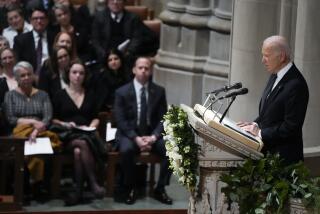Ginsburg has surgery for early-stage pancreatic cancer
- Share via
WASHINGTON AND LOS ANGELES — Supreme Court Justice Ruth Bader Ginsburg, only the second woman to serve on the nation’s highest court, had surgery Thursday for pancreatic cancer, a highly lethal form of the disease that the court said in a statement was caught in its early stages.
The cancer was discovered during a routine scan in late January. Ginsburg, 75, who was treated for colon cancer in 1999, had experienced no symptoms before the discovery, the court said. She is expected to remain at Memorial Sloan-Kettering Cancer Center in New York for seven to 10 days.
White House spokesman Robert Gibbs said President Obama’s “thoughts and prayers are with her right now, and we hope for and wish her a speedy recovery right now.”
Ginsburg, appointed to the court by President Clinton in 1993, was a trailblazing advocate for women’s rights earlier in her legal career. She co-founded the Women’s Rights Project at the American Civil Liberties Union and filed lawsuits seeking to abolish statues that discriminated on the basis of gender, arguing several cases before the high court.
Pancreatic cancer is the fourth leading cause of cancer death in the United States. With nearly 38,000 victims a year, only about 5% survive for five years after diagnosis, primarily because the disease has usually begun spreading widely before symptoms appear.
The key, doctors said, is whether the cancer has spread beyond the pancreas.
If it has not, then Ginsburg “is a very lucky woman,” said Randolph Hecht, director of the gastrointestinal oncology program at UCLA’s Jonsson Comprehensive Cancer Center. Ginsburg’s tumor, about a half-inch across, was found in the center of the pancreas. Because it was so small and localized, she probably has a 30% to 40% chance of surviving for five years, Hecht said.
The only curative treatment for pancreatic cancer is surgery, and that is effective only if it is identified early.
The fact that Ginsburg underwent surgery, however, is encouraging, said Dr. Gagandeep Singh, director of the Liver and Pancreas Center at John Wayne Cancer Institute in Santa Monica.
Only 5% to 10% of pancreatic cancer patients have either Stage 1 or 2 cancer and qualify for surgery, he said. If the cancer has spread, then Ginsburg could undergo chemotherapy.
Prominent victims of the disease in recent years include opera star Luciano Pavarotti and actor Michael Landon. Steve Jobs, chief executive of Apple Inc., has a less common endocrine tumor of the pancreas, which is typically curable with simple surgery.
Anytime a member of the Supreme Court develops a health issue, court-watchers inevitably begin speculating about a possible retirement. It was a drama that chased the late Chief Justice William H. Rehnquist for years until his death from thyroid cancer in 2005. In this case, a Ginsburg retirement would probably not change the balance on the court, as Obama would probably appoint a like-minded person to replace her.
But before her illness, Ginsburg never hinted at retirement and in fact, in a speech she delivered at Columbia Law School in October, she suggested that she would like to remain on the court into her 80s. She had months of radiation and chemotherapy for her colon cancer in 1999, and she never missed a day on the court during her recovery.
In the speech, she said Justice Louis D. Brandeis “became a justice at age 60, as I did. He remained on the bench until age 83. My hope and expectation is to hold my office at least that long.”
Still, the news comes at an unsettled time for the fledgling Obama administration. Lawyers in the White House and the Justice Department who would be involved in vetting a potential Supreme Court appointment are still settling in and are probably busy screening candidates for unfilled upper-level administration posts.
Ginsburg has been considered one of the court’s most liberal members. She has been a consistent advocate for civil rights and abortion rights. Ironically, she is closest on the court to conservative Antonin Scalia. They enjoy a mutual passion for opera.
She is probably best known for the opinion she wrote in 1996 invalidating the Virginia Military Institute’s ban on admitting women.
During the 2006-07 term, she took the unusual step of reading aloud from the bench two forceful dissents in cases involving equal pay for women and a federal law banning certain abortions called “partial birth” abortions by opponents.
“Women, it is now acknowledged, have the talent, capacity and right to participate equally in the economic and social life of the nation,” Ginsburg said in the latter case.
“Their ability to realize this full potential . . . is ultimately connected to their ability to control their reproductive lives.”
David Schizer, dean of Columbia Law School, who clerked for Ginsburg in 1994, said of her health problems: “I know Justice Ginsburg to be a person of great courage and strength who will confront this challenge with her remarkable energy and commitment.”
Ginsburg became the first tenured female law professor at Columbia, in the 1970s; and her daughter, Jane, is on the faculty there.
She served as an appellate judge in Washington before her Supreme Court appointment.
Ginsburg has lamented her role as the court’s sole woman after the retirement of Sandra Day O’Connor in 2006.
Should a Supreme Court opening surface during Obama’s first term, many expect the nominee to be a woman.
If Ginsburg were to retire, that would make it even more likely.
--
thomas.maugh@latimes.com
More to Read
Sign up for Essential California
The most important California stories and recommendations in your inbox every morning.
You may occasionally receive promotional content from the Los Angeles Times.












